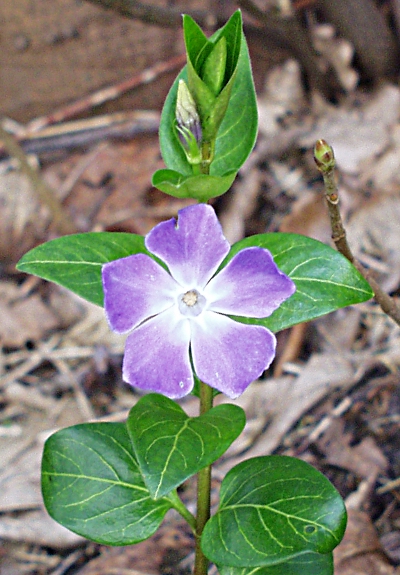Vinca, periwinkle |

Large periwinkle (Vinca major)

Lesser periwinkle (Vinca minor) - white cultivar
Since it is an evergreen, and thus virtually defeated the winter, Vinca could also originate from vincere. Even the part of name pervinca leads to no hot lead, because it might have been derived from both pervincire and of pervincere. They have the same meaning as the verb without the slightly intensifying prefix "per".
By using as a garden plant, the genus now has spread throughout the world, its origins are, however, in the Mediterranean region.
The approximately 12 periwinkle species are perennial, ground covering perennials. The leaves are entire, oval to egg-shaped, leathery and opposite. In bud stage the petals are helically wound.
The stalked flowers which are standing in the leaf axils, are hermaphroditic, actinomorphic and pentamerous. The petals are fused at the base into a tube, the corolla lobes are spreading (salverform). The stamens are pentamerous, the superior ovary is composed of two carpels, which are more or less fused and form only one stylus.
| Floral formula: |
| * K(5) C(5) A5 G(2) superior |
The flowers are visited by butterflies and moths and bees, self-pollination also is possible. Mostly 2 follicles are formed.
Evergreen, semi-evergreen, deciduous
A plant called evergreen, when their leaves reserves throughout the winter until the next flowering season. Some plants remain almost the entire winter leafy, but lose their leaves before the next flowering, they are called "semi-evergreen".
The foliage of evergreen plants is often thicker and more resistant than that of deciduous ones, which carrying their leaves only from spring to autumn. In addition, it has mostly a thick wax layer (cuticle) to protect against evaporation. It is necessary because the ground in winter is often frozen, so that the water is fixed as ice and not available for the plants. In summer, the wax layer partly reflected the sunlight, thereby it protecting the leaf from overheating.
Periwinkle in cancer therapy
From the Madagascar periwinkle (formerly Vinca rosea, today Catharantus roseus) alkaloids are gained, such as vinblastine or vindesine, used in cell research and in cancer therapy. They prevent the cell division by blocking the formation of the mitotic spindle, which ensures the distribution of chromosomes between the two daughter cells. The cells then die off.
Since cancer cells divide more often than ordinary body cells, the effect on the carcinoma is greater than that on the healthy cells. Since these are also blocked in their division, there are unwanted side effects such as hair loss or weakening of the immune system.
Historial publications
Pliny (about 23–79 AD.) wrote about "Vincapervinca" (Vinca minor, lesser periwinkle), it was always green and a plant of the gardeners and it sometimes would replace the lack of flowers. The Greeks would call it Chamaedaphne. Dried and crushed it would help against dropsy.
The large periwinkle (Vinca major) would be called Egyptian clematis. It have long thin stems and leaves like laurales and would drink with vinegar against snakebites.
Dioscorides (1st century AD.) mentions a plant named Clematis and recommended to chew the leaves, among others, for toothache. Plant parts drunk with wine, would cure diarrhea and drunk with vinegar it would act against bites of asp (Vipera aspis). The plant would creep along the ground and possesses small twigs, the leaves would resemble the laurel, but they were much smaller. Whether he meant Vinca minor or Clematis daphnoides, however, is not certain.
Leonhart Fuchs (1501–1566) collected the descriptions of healing effects of the lesser periwinkle by ancient authors and supplemented them partly. The plant would called "Syngrüen" because it always stay green.
Meanig of the species names
- major: lat. major = greater
- minor: lat. minor = lesser
Interesting notes
-
The lesser periwinkle was introduced around the 15th century as an ornamental plant from southern Europe. Because it can survive for hundreds of years, and is spread only by humans, it displays today the locations of ancient settlements.
-
Vinca minor for a long time has been used in folk medicine. By contained vincamine it could for example improve circulation and reduce blood pressure. Commercially available preparations on the basis of periwinkle are forbidden today, because impurities can cause changes in the composition of the blood.
-
Intoxications with periwinkle provoke lowering blood pressure, cardiovascular ailments and respiratory distress.